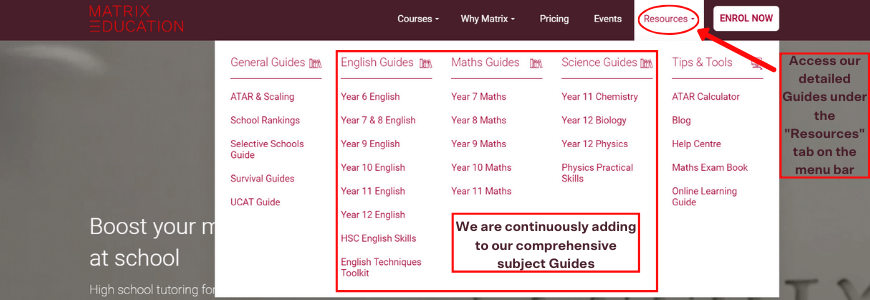Welcome to Matrix Education
To ensure we are showing you the most relevant content, please select your location below.
Select a year to see courses
Learn online or on-campus during the term or school holidays
Learn online or on-campus during the term or school holidays
Learn online or on-campus during the term or school holidays
Learn online or on-campus during the term or school holidays
Learn online or on-campus during the term or school holidays
Learn online or on-campus during the term or school holidays
Learn online or on-campus during the term or school holidays
Get HSC exam ready in just a week
Select a year to see available courses
Science guides to help you get ahead
Science guides to help you get ahead

Are you a parent wondering where to start teaching your child using online resources? Things are stressful enough without worrying about your child falling behind. Don’t worry, we’re here to help. In this article, we’re going to talk about how to effectively use online learning with your child. We’ll explain the processes you should be following and the sorts of things you need to take into consideration to best help your child.
If you’re not an educator, helping your child through online learning can be a frightening prospect. Most parents are unsure of where to start and lack the confidence to start helping your child. To best help our community, in this article, we’re going to discuss the process and other considerations you need to best support your child.
We’re going to discuss, the importance of:
Remember, you are not alone during these tough times. Matrix is here to help support the community.
It’s really important that you can get connected as best as possible to assist your child’s learning. As school-based learning moves online, teachers are going to be using resources like Google Classroom, Canvas (the framework for Matrix LMS) and other delivery systems to instruct children. You need to make sure you have:
If you do not have these at home, speak to your school. The Education Department is updating this page regularly with the current services they can offer. If students don’t have access to the internet, USBs containing resources and learning materials will be sent to students and schools have permission to provide laptops to students that don’t have them. Currently, the NSW Education Department is working to organise internet access for students without it.

Other resources you want to have handy at home include:
Making sure that you are properly resourced in terms of equipment will make setting up an appropriate learning environment easier.
Matrix has supported thousands of students over the last 20 years. Learn more about how Matrix+ online courses can help your child succeed, here.
Get ahead with Matrix+ Online
Expert teachers, detailed feedback and one-to-one help. Learn at your own pace, wherever you are.
To help your children learn effectively and consistently, you need to set up a learning space for them.
Having a space where they say and think, “Now I am in the space where I learn!”, will help them prepare and focus.
This is something that can be tricky to organise. While some houses have dedicated studies or offices, many others, who live in units, may struggle to develop a dedicated space. You can find detailed information about creating a study space in this article, here. Ideally, you want to avoid using the bedroom or TV/lounge room as a classroom space, but sometimes this may be impossible to avoid.
Some good rules to follow are:
Take the time to discuss the learning area with your child and other family members to ensure that they can have undisturbed study time. You may need to organise a roster for the space if you have multiple children and/ or have to work from home yourself.
You may want to consider your child’s learning styles before you put a learning space together.
All children learn differently. One of the significant challenges educators face is figuring out what sort of learner a student is. They then need to facilitate that in the classroom.
You need to ascertain if your child is a:
These are learners who pick up information best from images and mindmaps. If your child prefers to visualise plans and likes using maps, they are likely a spatial learner. To help them learn you should allow them to plan and draw things up before beginning written work.
These are learners who predominantly pick up information and process it through sound. If your child enjoys using mnemonics and songs to remember and recall information they are possibly an aural learner. If your child is an aural learner, let them establish an auditory environment that best facilitates their learning.
These are learners who prefer to learn from written and verbal instruction. If your child likes increasing their vocabulary and enjoys independent reading and writing, they are a linguistic learner. You can assist these learners by finding them written resources and reading things aloud to them.
Kinesthetic learners are physical learners. They need to move around a lot and like to go for a walk or run to process information and think things through. If your child has a tendency to doodle or likes practical puzzles like jigsaws and building models, they may be a physical learner. You can help them learn through role-play and asking them to draw their own diagrams and flowcharts.
As you can guess, these are numerical learners. They need logic and structure to process information and understand it. If your child likes to classify information to understand it and follow strict procedures and agendas, they are likely a mathematical learner. You can help them learn by focusing on the logic, reasoning, and systems behind the idea or concept.
These are interpersonal learners. Social learners learn by discussing information with others. Social learners need to bounce ideas off others and tend to listen actively. You can help social learners by organising group work with other parents. Group tasks are designed to facilitate learning for social learners and teach communication skills to those who are less comfortable with things.
Solitary learners prefer to gain knowledge independently. Solitary learners have a tendency to set goals, keep a journal or diary, and have strong self-management skills. Solitary learners can be highly effective, but you have to develop their trust. Encourage them to set regular targets and keep their school diary active and let them work through things at their own pace. Make sure you try and discuss what they struggle and excel with regularly as they may not be as comfortable discussing things like this.
Your child may be one or several of these. You need to figure out which traits your child has and tailor their learning environment and schedule to suit this.

When helping your child learn at home using online resources, it is important that you maintain a structure and routine.
You need to maintain a routine so that your child can stay focused but also so you don’t overload them!
As much as children may need a push to get them studying and motivated, they also need time to relax and process information.
When students learn in the classroom over a 6 hour day, the teacher is trying to balance their time amongst up to 35-40 children. This means that learning for each item takes longer so that the teacher can bring the whole class along together.
At home, they may learn things faster and possibly (but not always, and that is okay!) need less time for that lesson.
So, what things do you need to take into account to help your child learn? Let’s see.
Maintaining a consistent routine is one of the most important things during this challenging period. You need to bring stability to your child and their learning when there is so much rapid change and uncertainty.
Before you being each week, make sure you plan the whole week.
Develop a morning routine for before study. Make sure to include:
To maintain effective study habits and practices, you need to set goals about the amount of content they will complete and the sorts of skills they need to acquire.
Most textbooks are structured so that students complete tasks in week-long study blocks. When studying online and at home, you need to discuss sensible and achievable goals for the day, and then the week, with your child and their teacher. Don’t set unrealistic goals, this is counterproductive.
Before you start to study each week, you should write down a list of weekly study goals. Before learning starts for each day, plan the goals that you, the child’s teacher, and your child feel needs to be accomplished or at least largely achieved.
You must plan regular breaks and downtime for your child. Learning online and at home is significantly different to learning in a classroom. In a room full of 30 students, children progress through work much slower than at home. A teacher needs to assist up to 30 students, whereas at home you have far fewer children to assist.
Some things to keep in mind are:
If students are at home all the time, they need to be able to have time away from studying.
Both you and your child need to switch off. Neither of you can study all day, every day!
So, set some rules and follow them to make sure you all relax and maintain a regular family relationship:
You can find more information about planning your study in Part 1 of this guide.
While your child is away from school, you need to take an active role in their learning (not that you wouldn’t if they were at school!). This means that you should have a sense of the things they are studying at school for that year and term.
You don’t need to be a curriculum or subject matter expert, but you should know what your child is meant to be studying. During a period of shutdown, isolation, or online distance learning, your teacher will give you and your child guidance on what they are learning.
To help you stay informed and better able to help, you should familiarise yourself with the following websites:
This is the website for information about the NSW curriculum. Information on this website, is more accessible that the National Curriculum website (below).
Curriculum information is broken by stage, year, and subject. Parents will find it easiest to have a look at the overviews for:
This is the national website for the Kindergarten to Year 10 curriculum. On this site, you will find detailed information about each subject for those years.
They also provide some parent-specific information sheets for:
This website is designed for teachers and other educators, so it is quite detailed and can be overwhelming for parents.
The Matrix website has detailed guides for all subjects and years. In addition, the Matrix LMS for subjects that your children are enrolled in contains:
You can learn more about Matrix online learning, here.

To effectively support your child’s learning, you need to have regular discussions with them. You need to find out how they feel about their work:
You should also maintain consistent communication with their teachers at school and Matrix. Your child’s teachers will understand their competencies and weaknesses as well as their learning style.
Make sure you sit down with your child and make a list of things they are finding difficult for each subject. Try and make this list as specific as possible, that will make it easier for the teacher to provide practical and detailed advice.
Things you need to discuss with your child’s teachers are:
Try to do as much discussion as you can by email so that have detailed notes to refer to. Digital communication makes it easier for your child’s teachers to share appropriate resources with you like PDFs or links.
If your child is feeling anxious or stress, take the time to read and share articles on wellbeing and mental health with them.
You should also try and communicate with the parents of your child’s peers.
Continuing peer group learning, if it is online and remote, will help them continue to learn.
You should make sure that your child participates in the online discussion groups and classroom spaces for school. Similarly, the Matrix LMS includes a Question and Answer Discussion Space for each subject where your child can ask questions. We have also set up an exclusive Facebook group for currently enrolled students to keep them supported during this time.
In this difficult time, it is important that parents get the support they need to. You might be in isolation, but you shouldn’t be isolated.
Take the time to join any online support groups you can. This is an excellent opportunity to engage and connect with your fellow parents as well as get the support you’re going to need.
Form a discussion group on WhatsApp, WeChat, or a similar platform with other parents. Matrix is providing a Facebook group to support parents of our students and give them a place where they can ask for and share advice and support with one another. This will give you a place where you can discuss:
It is important that you look after yourself as well as your children. If you don’t give yourself downtime or get help when you need it, you can’t support others. If you are looking for support to aid your child’s online learning, you can learn more about how Matrix can support you, here.
The Matrix Resources and Guides have information to make your life as a parent easier:

© Matrix Education and www.matrix.edu.au, 2023. Unauthorised use and/or duplication of this material without express and written permission from this site’s author and/or owner is strictly prohibited. Excerpts and links may be used, provided that full and clear credit is given to Matrix Education and www.matrix.edu.au with appropriate and specific direction to the original content.